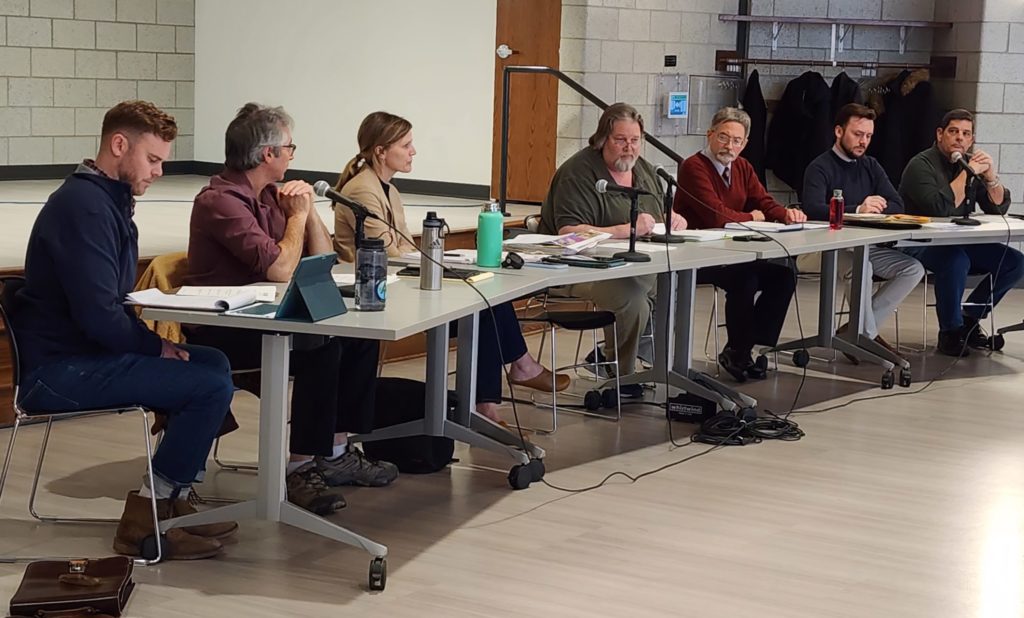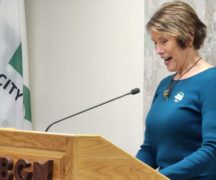By JAN LARSON McLAUGHLIN
BG Independent News
It appears Bowling Green City Council is trying to make its zoning code update more neighborly in older residential areas surrounding the downtown.
On Monday evening, council held the first of three public forums on the proposed zoning code update. The meeting was designed for council members to discuss the proposal – with no input from the public. The next meeting will be March 23, when the public will be invited to speak.
Though citizens didn’t participate in Monday’s meeting, their voices were heard. After months of listening to citizens’ concerns about protecting their neighborhoods, council members Jeff Dennis and Rachel Phipps introduced a compromise intended to:
- Scale back the commercial uses in the proposed Pedestrian Residential district.
- Implement the mixed-use concept in a more incremental fashion by instead permitting residential uses in areas of commercial and manufacturing that currently exist in the proposed Pedestrian Residential district.
The compromise zoning proposal received support from the entire City Council Monday evening.
“We removed nearly all the commercial uses” in the Pedestrian Residential district, Phipps said.
And the compromise responds to “folks who feel their neighborhoods are already overburdened by rentals,” she said.
Though the compromise doesn’t go as far as a “Central Residential District” zoning proposal submitted by citizens, it meets them halfway.
“It is very much a response to what we heard from the community,” Phipps said.
And it’s just “a starting point,” Dennis added. “This is a living, breathing document that we will continue to revise.”
The biggest concerns for some residents seem to be that PR zoning would allow several types of small businesses to locate in residential neighborhoods, and that it would encourage more rental housing in the older neighborhoods surrounding the downtown area.

Council member Bill Herald thanked Phipps and Dennis for their work to create the compromise. And he praised the citizens who have been relentless in their pursuit of a zoning code that protects their neighborhoods.
“It’s been a good lesson in democracy,” Herald said. “I want to thank each and every one of you for taking the time.”
The compromise is a clear message that citizens “have a continued say in this,” council member Nick Rubando said. Rubando said he understands citizen concerns about the initial Pedestrian Residential zoning plan. The compromise is something the city and council members can be proud of, he said.
The compromise plan limits the number of permitted business uses in the PR zones. The permitted uses are:
- Adult group homes
- Passive greenspace
- Professional offices
- Side/rear parking pads
- Two-unit dwellings
- One-unit dwellings
- Bed & breakfasts
The permitted uses no longer include corner stores. And no longer allowed among conditional uses would be bars or taverns, microbreweries or distilleries, retail sales, and rooming/boarding houses.
The conditional uses would be:
- Accessory dwelling units
- Nursing homes
- Places of worship
- Retail services
- Primary or secondary schools
- Vocational training schools
- Telecommunications facilities
- Some types of home day care
- Barbers, beauty salons, spas
- Campus ministries
- Day care centers
- Mortuaries or funeral homes
The compromise proposal also identifies areas in the blocks surrounding the downtown that are currently zoned light manufacturing or business. Under the new plan, those pockets would allow residential uses.
Dennis pointed out that most residents are likely unaware that current zoning would allow an airport and landing field off South Maple Street.
The specifics of the zoning code could also set architectural design standards so any new buildings do not detract from and will add value to the surrounding neighborhood.
The compromise zoning proposal was made with input from Mayor Mike Aspacher, Municipal Administrator Lori Tretter, Planning Director Heather Sayler, and ZoneCo, the firm hired to work on the zoning update.
Council member Greg Robinette said he believed the city is progressing toward its established goals through zoning. However, he also said council needs to consider the citizen-proposed “Central Residential District” in place of the Pedestrian Residential zoning.
Unlike the proposed PR zoning, the Central Residential District would not increase lot coverage or shrink setbacks. In the proposal presented to council last month, the Central Residential zoning would permit one-unit dwellings, side yard or rear yard parking, adult group homes, and passive greenspace. Uses that would alter or diminish the character of the areas would not be allowed, such as all business uses and two-unit dwellings.
“It deserves a fair hearing,” Robinette said.
Council was split on the issue of whether or not to tackle regulations for Bed & Breakfasts and short-term rentals now before the zoning update goes to a vote. Citizens brought it to council’s attention recently that the city lacks controls for such property uses.
Council member Joel O’Dorisio agreed the topic should be addressed, but said it should be regulated through the city’s rental registration policy.
Dennis said the issue should be addressed now, while Council President Mark Hollenbaugh voiced concerns that adding more to the zoning update process would slow it down.
Council members also briefly discussed the addition of dog parks as conditional uses in some zoning designations, amending the factors considered when granting a conditional use, and possibly amending the city’s future land use map.
Robinette pointed out that the city’s proposed zoning map and the land use map are conflicting. He suggested that the zoning map be revised.
City Council’s final work session on the zoning update is set for March 27, at 6 p.m., in the Veterans Building in City Park. Council President Mark Hollenbaugh said council will vote at that meeting on items to include or exclude from the zoning update.
There is still time left for community input, with a public forum on March 23, plus City Council’s three readings of the legislation on March 20, April 3 and 17.
To view the zoning code update webpage, go to www.bgohio.org and click on the Zoning Code Update box in the Community Spotlight.



